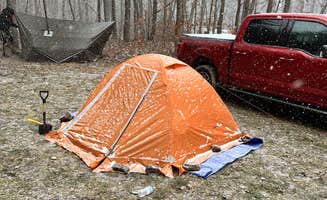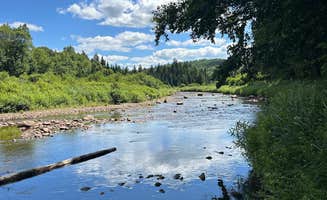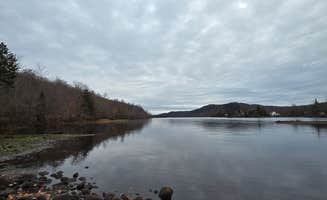Dispersed camping near Sprakers, New York extends beyond state forests to include several primitive sites along waterways and reservoirs within the Mohawk Valley region. The area sits at elevations between 600-1,500 feet with seasonal weather patterns typical of upstate New York, including snowy winters and mild summers. Road access varies significantly between locations, with many sites requiring high-clearance vehicles during spring thaw conditions.
What to do
Fishing opportunities: At Powley Road in Ferris Wild Forest, campers can access the river directly from their sites. "Site 4 is magical, it is road side, but the view, and access to the river is great. There is a path right from the site," notes one visitor. The area requires proper fishing licenses and offers both catch-and-release and seasonal harvesting.
Winter camping: Burnt Rossman State Forest provides accessible winter camping options when many other sites close. A camper reports, "Was a great location for winter camping. Site easily accessible from road. Beautiful, peaceful, great time!" Winter visitors should bring appropriate cold-weather gear and check road conditions before attempting access.
Mountain biking: State forests around Sprakers contain multiple trail systems suitable for cycling. At Ushers Road State Forest, "This trailhead provides access to bicycle-friendly nature trails. I explored both directions on my bike, riding approximately half a mile down each side." The terrain varies from hardpack to occasional wet sections requiring fat tires during spring months.
What campers like
Secluded stream access: Betty Brook Camp provides direct streamside camping in a remote setting. "Love to camp here all year long have been coming to the area for a couple of decades now. Remote. Sometimes you never see anyone. Sometimes you see some people. You camp on the stream," shares a regular visitor. The small sites accommodate tents and small trailers.
Waterfront views: The morning views at North Lake Reservoir Campground reward campers who arrive after dark. "Very remote and secluded. We got there after dark and it was beautiful to wake up to the view of the lake. Car camped, but there was enough room for a tent," reports one visitor. The reservoir features 32 sites situated around the shoreline.
Off-grid solitude: Duck Pond Campsite provides a balance of accessibility and remoteness. "After driving unpaved dirt road for a while, we arrived a surprisingly well maintained beautiful campsites. So few people passed by and very unknown quite and we just loved the experience," explains a camper. Sites maintain separation despite proximity to the small pond.
What you should know
Road conditions: Access roads to most dispersed sites require careful driving and appropriate vehicles. A camper at Powley Road warns, "The road is in good condition. No AT&T cell service in this area." Similar conditions exist at other state forest camping areas, with seasonal variations affecting accessibility.
Site numbering systems: Some forests implement numbered site systems to manage dispersed camping. "Must camp at a numbered site. Most sites are right along the road, but I was lucky enough to snag one deeper in the woods," explains a visitor to Powley Road. Unnumbered camping spots must typically maintain 150-foot distance from trails and water sources.
Limited facilities: Fort Plain Lock 15 on Empire Trail provides more amenities than most dispersed sites in the region. "At the lock parking area, you'll find pit toilets, a dumpster, and potable water available on the side of the building as you enter," notes one camper. Most other locations provide only basic fire rings without water sources.
Tips for camping with families
Consider site proximity to roads: Many dispersed sites sit close to infrequently traveled roads. At Betty Brook Camp, a local resident notes, "It is rather remote, but it is right along West kill road. There's a stream alongside it, a fire pit, and a town about 8 mi away. It's a small town, with just a gas station store." This proximity allows easier access for families with young children while maintaining a wilderness experience.
Wildlife viewing opportunities: Fort Plain Lock 15 provides wildlife observation chances suitable for children. One visitor noted it's "a great spot for wildlife viewing and fishing (with a valid license)." The resident peacock mentioned by another camper adds unexpected wildlife encounters for young campers.
Check noise factors: Some sites experience ambient noise that might affect light sleepers. A camper at Burnt Rossman State Forest - Westkill Camp noted, "This spot is right off the road. Nice and quiet." However, at Fort Plain Lock 15, a visitor mentions, "It offers sounds of the highway and freight trains going by, my wife and I love it. If you need quiet, keep on moving."
Tips from RVers
Site capacity limitations: Most dispersed sites cannot accommodate large rigs. A Betty Brook Camp reviewer advises, "I would not recommend this for large trailers. The site is fairly small, but it's in state park, and there's tons of walking that can be done." Small trailers and truck campers fare better at most locations.
Seasonal access considerations: Spring conditions often limit RV access to these areas. Duck Pond Campsite requires particular caution: "The road in on old cemetery rd was pretty rough, so we decided to go out the other way, which was way worse." Many sites become accessible to small RVs only during summer and fall months.
Parking surface quality: Fort Plain Lock 15 provides defined parking but with limitations. "The parking lot is large, rocky, and uneven, situated right on the Mohawk River," reports a visitor. Most other dispersed locations lack clearly defined parking areas, requiring careful site selection for vehicle positioning.




